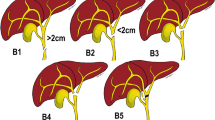Abstract
Purpose
Pediatric experience with biliary tract injuries (BTI) is limited and mostly consists of case presentations. The purpose of this study is to evaluate clinical and radiological findings of possible BTI, treatment strategies, and results.
Methods
The records of nine patients with the diagnosis of BTI between July 2009 and November 2017 were reviewed retrospectively.
Results
There were seven boys and two girls (mean 8.05 ± 4.39 years). The mechanisms were motor vehicle occupant, fall, crush and gunshot wound. Hepatic laceration routes that extended into the porta hepatis and contracted the gall bladder were demonstrated on computerized tomography (CT). Bile duct injury was diagnosed with bile leakage from the thoracic tube (n = 2), from the abdominal drain (n = 2) and by paracentesis (n = 5). Extrahepatic (n = 8) and intrahepatic (n = 1) bile duct injuries were diagnosed by cholangiography. Endoscopic retrograde cholangiography, sphincterotomy, and stent placement were successfully completed in five patients. Peritoneal drainage stopped after 3–17 days of procedure in four patients. The fifth patient was operated with the diagnosis of cystic duct avulsion. Cholecystectomies, primary repair of laceration, cystic duct ligation, and Roux-en-Y hepatoportoenterostomy were performed in the remaining four patients. All patients presented with clinically normal findings, normal liver functions, and normal ultrasonographic findings in the follow-up period.
Conclusions
The presentation of the parenchymal injury extending to the porta hepatis with contracted gall bladder on CT and diffuse homogenous abdominal fluid should be considered as signs of BTI. We suggest a multi-disciplinary approach for the diagnosis and treatment of BTIs. Surgery may be indicated according to the patient’s clinical condition, radiological findings and failure of non-operative treatment.






Similar content being viewed by others
References
Gross M, Lynch F, Canty T Sr, Peterson B, Spear R (1999) Management of pediatric liver injuries: a 13-year experience at a pediatric trauma center. J Pediatr Surg 34:811–817
Christmas AB, Wilson AK, Manning B, Franklin GA, Miller FB, Richardson JD, Rodriguez JL (2005) Selective management of blunt hepatic injuries including nonoperative management is a safe and effective strategy. Surgery 138:606–611
Landau A, van As AB, Numanoglu A, Millar AJ, Rode H (2006) Liver injuries in children: the role of selective non-operative management. Injury 37:66–71
Castagnetti M, Houben C, Patel S, Devlin J, Harrison P, Karani J, Heaton N, Davenport M (2006) Minimally invasive management of bile leaks after blunt liver trauma in children. J Pediatr Surg 41:1539–1544
Sawaya DE Jr, Johnson LW, Sitting K, McDonalds JC, Zibari GB (2001) Iatrogenic and noniatrogenic extrahepatic biliary tract injuries: a multi-institutional review. Am Surg 67:473–477
Carrillo EH, Spain DA, Wohltmann CD, Schmieg RE, Boaz PW, Miller FB, Richardson JD (1999) Interventional techniques are useful adjuncts in nonoperative management of hepatic injuries. J Trauma 46:619–622
Kulaylat AN, Stokes AL, Engbrecht BW, McIntyre JS, Rzucidlo SE, Cilley RE (2014) Traumatic bile leaks from blunt liver injury in children: a multidisciplinary and minimally invasive approach to management. J Pediatr Surg 49:424–427. https://doi.org/10.1016/j.jpedsurg.2013.07.015
Sanders DW, Andrews DA (2000) Conservative management of hepatic duct injury after blunt trauma: a case report. J Pediatr Surg 35:1503–1505
Sharif K, Pimpalwar AP, John P, Johnson K, Donnell S, de Ville de Goyet J (2002) Benefits of early diagnosis and preemptive treatment of biliary tract complications after major blunt liver trauma in children. J Pediatr Surg 37:1287–1292
Sharma BC, Mishra SR, Kumar R, Sarin SK (2009) Endoscopic management of bile leaks after blunt abdominal trauma. J Gastroenterol Hepatol 24:757–761. https://doi.org/10.1111/j.1440-1746.2008.05703.x
Almaramhi H, Al-Qahtani AR (2006) Traumatic pediatric bile duct injury: nonoperative intervention as an alternative to surgical intervention. J Pediatr Surg 41:943–945
Sharpe RP, Nance ML, Stafford PW (2002) Nonoperative management of blunt extrahepatic biliary duct transection in the pediatric patient: case report and review of the literature. J Pediatr Surg 37:1612–1616
Nathan M, Gates J, Ferzoco SJ (2003) Hepatic duct confluence injury in blunt abdominal trauma: case report and synopsis on management. Surg Laparosc Endosc Percutaneous Tech 13:350–352
Church NG, May G, Sigalet DL (2002) A minimally invasive approach to bile duct injury after blunt liver trauma in pediatric patients. J Pediatr Surg 37:773–775
Bridges A, Wilcox CM, Varadarajulu S (2007) Endoscopic management of traumatic bile leaks. Gastrointest Endosc 65:1081–1085
Shah JN (2007) Endoscopic treatment of bile leaks: current standards and recent innovations. Gastrointest Endosc 65:1069–1072
Poli ML, Lefebvre F, Ludot H, Bouche-Pillon MA, Daoud S, Tiefin G (1995) Nonoperative management of biliary tract fistulas after blunt abdominal trauma in a child. J Pediatr Surg 30:1719–1721
Monk JS Jr, Church JS, Agarwal N (1991) Repair of a traumatic noncircumferential hepatic bile duct defect using a vein patch: a case report. J Trauma 31:1555–1557
Ulitsky A, Werlin S, Kulwinder SD (2011) Role of ERCP in the management of non-iatrogenic traumatic bile duct injuries in the pediatric population. Gastrointest Endosc 73:823–827. https://doi.org/10.1016/j.gie.2010.11.054
Author information
Authors and Affiliations
Corresponding author
Ethics declarations
Conflict of interest
The authors declare that they have no conflict of interest.
Research involving human participants and/or animals
This article does not contain any studies with human participants or animals performed by any of the authors.
Rights and permissions
About this article
Cite this article
Temiz, A., Ezer, S.S., Gedikoğlu, M. et al. Management of traumatic bile duct injuries in children. Pediatr Surg Int 34, 829–836 (2018). https://doi.org/10.1007/s00383-018-4295-4
Accepted:
Published:
Issue Date:
DOI: https://doi.org/10.1007/s00383-018-4295-4




